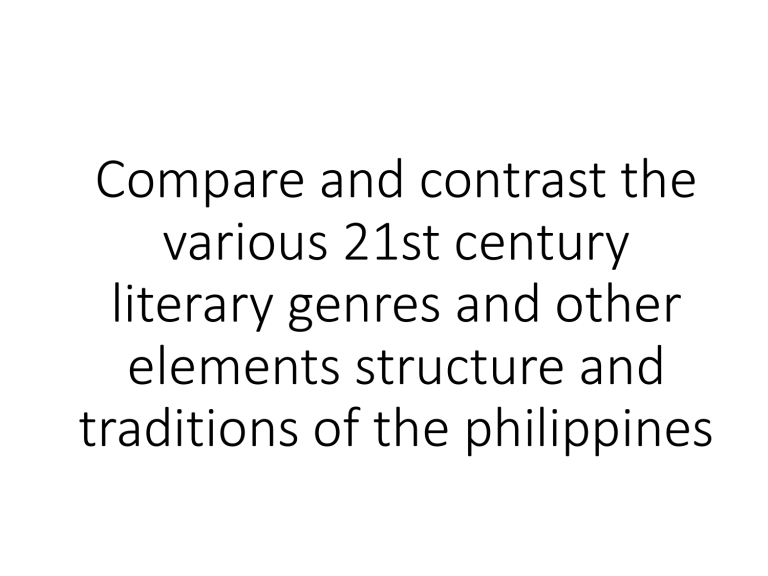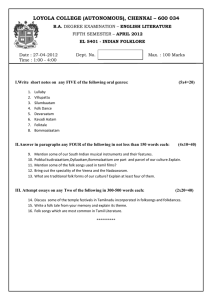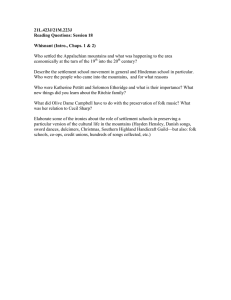
Compare and contrast the various 21st century literary genres and other elements structure and traditions of the philippines Compare and contrast • Traditional Literature cannot that be defined. We have many recognized movements in literature that start around the renaissance. And after this era or period, literature cannot be defined as traditional or modern because like language, literature can be dynamic and arbitrary. • • • • But let’s try harder? Here’s a comparison of literature before and now: literature before has a strict conformity on system, norm, elitism, and romanticism while literature now can have free verse, focus on peculiar subjects, unconventional point of views, and topics can be about technology and new knowledge. • • • • Literature starts way back in prehistory when everything was in the oral tradition. But literature before and after 21st century have oral lore. Before, mythology and epics were being told to generations and to generations while our contemporary literature have spoken word performances, poetry reading, etc. • • • • Creative writing were both penchants of writers before and after 21st century, but the topics maybe different such as: human versus god before while human versus artificial intelligence now. This is about difference between 21st century and 20th century literature or in other words, this is about classic vs modern literature. • • If traditional means not-modern and modern means 21st century… traditional articles would be in the realm of expected formats such as sonnets that would follow designated meters and rhyme schemes while 21st century literature themes and rhymes are unconventional and much more of an avant-garde. • • • • • Here’s another difference of 21st century literature, modernists would be more in lines of free verse, no set rhyme scheme, or format unlike conventional writers. • • • • Again, the difference would be traditional follows expected forms and formats while modern deviates. Anyways, there are disadvantages too on modernism. Here’s a related link: Is the experience of reading literature more important than googiling information on the internet?why or why not brainly.ph/question/612174 • • • • Ancient literature, if that’s what you mean by traditional literature, was predominantly oral, didactic and mythical, full of romanticism and idealism. Modern writers are revolutionary and has this genre such as Dadaism to publish. • Modern literature is predominantly written or audio-visual while ancient literatures were spoken. • • • • We have much better libraries today, right? That would be ancient scrolls versus computerized library systems. • • • • Mythologies and epics are common before modern era. Unlike now, we read tweets and FB statuses. • • • • One thing that is very important to remember is that the term “modern” poetry is used to describe both recent poems and poetries written during specific literary period referred to as “Modernism”. However, here’s a shocker, traditional poets were not “traditional” at the time. They just known for inventing the forms we know and study today. • Some say that the small differences between ancient and modern literature are actually hidden in shifts in language. • • • • Modern literature has this development of human consciousness with a freer exchange of ideas. The literature nowadays has shifted from bigger and more basic human drive issues of survival. Philippines literature • The diversity and richness of Philippine literature evolved side by side with the country's history. This can best be appreciated in the context of the country's pre-colonial cultural traditions and the socio-political histories of its colonial and contemporary traditions. • • The average Filipino's unfamiliarity with his indigenous literature was largely due to what has been impressed upon him: that his country was "discovered" and, hence, Philippine "history" started only in 1521. • • So successful were the efforts of colonialists to blot out the memory of the country's largely oral past that present-day Filipino writers, artists and journalists are trying to correct this inequity by recognizing the country's wealth of ethnic traditions and disseminating them in schools and in the mass media. • Japanese literature • The Japanese language itself also shaped poetic devices and forms. Japanese lacks a stress accent and meaningful rhymes (all words end in one of five simple vowels), two traditional features of poetry in the West. By contrast, poetry in Japanese is distinguished from prose mainly in that it consists of alternating lines of five and seven syllables; however, if the intensity of emotional expression is low, this distinction alone cannot save a poem from dropping into prose. The difficulty of maintaining a high level of poetic intensity may account for the preference for short verse forms that could be polished with perfectionist care. But however moving a tanka (verse in 31 syllables) is, it clearly cannot fulfill some of the functions of longer poetic forms, and there are no Japanese equivalents to the great longer poems of Western literature, such as John Milton’s Paradise Lost and Dante’s The Divine Comedy. Instead, Japanese poets devoted their efforts to perfecting each syllable of their compositions, expanding the content of a tanka by suggestion and allusion, and prizing shadings of tone and diction more than originality or boldness of expression. • The rousings of nationalistic pride in the 1960s and 1970s also helped bring about this change of attitude among a new breed of Filipinos concerned about the "Filipino identity." • • • • Pre-Colonial Times • • Owing to the works of our own archaeologists, ethnologists and anthropologists, we are able to know more and better judge information about our pre-colonial times set against a bulk of material about early Filipinos as recorded by Spanish, Chinese, Arabic and other chroniclers of the past. • • Pre-colonial inhabitants of our islands showcase a rich past through their folk speeches, folk songs, folk narratives and indigenous rituals and mimetic dances that affirm our ties with our Southeast Asian neighbors. • • • The most seminal of these folk speeches is the riddle which is tigmo in Cebuano, bugtong in Tagalog, paktakon in Ilongo and patototdon in Bicol. Central to the riddle is the talinghaga or metaphor because it "reveals subtle resemblances between two unlike objects" and one's power of observation and wit are put to the test. While some riddles are ingenious, others verge on the obscene or are sex-related: • The proverbs or aphorisms express norms or codes of behavior, community beliefs or they instill values by offering nuggets of wisdom in short, rhyming verse. • • The extended form, tanaga, a mono-riming heptasyllabic quatrain expressing insights and lessons on life is "more emotionally charged than the terse proverb and thus has affinities with the folk lyric." Some examples are the basahanon or extended didactic sayings from Bukidnon and the daraida and daragilon from Panay. • • The folk song, a form of folk lyric which expresses the hopes and aspirations, the people's lifestyles as well as their loves. These are often repetitive and sonorous, didactic and naive as in the children's songs or Ida-ida (Maguindanao), tulang pambata (Tagalog) or cansiones para abbing (Ibanag). • • A few examples are the lullabyes or Ili-ili (Ilongo); love songs like the panawagon and balitao (Ilongo); harana or serenade (Cebuano); the bayok (Maranao); the seven-syllable per line poem, ambahan of the Mangyans that are about human relationships, social entertainment and also serve as a tool for teaching the young; work songs that depict the livelihood of the people often sung to go with the movement of workers such as the kalusan (Ivatan), soliranin (Tagalog rowing song) or the mambayu, a Kalinga rice-pounding song; the verbal jousts/games like the duplo popular during wakes. • • Other folk songs are the drinking songs sung during carousals like the tagay (Cebuano and Waray); dirges and lamentations extolling the deeds of the dead like the kanogon (Cebuano) or the Annako (Bontoc). • • A type of narrative song or kissa among the Tausug of Mindanao, the parang sabil, uses for its subject matter the exploits of historical and legendary heroes. It tells of a Muslim hero who seeks death at the hands of non-Muslims.




